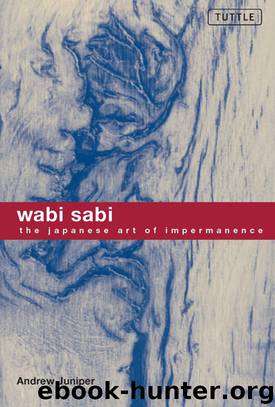Wabi Sabi by Andrew Juniper

Author:Andrew Juniper [Juniper, Andrew]
Language: eng
Format: epub
Publisher: Tuttle Publishing
Published: 2011-09-05T04:00:00+00:00
WABI SABI AND CERAMICS
Japan’s history of ceramics stretches back over ten thousand years and the vast array of uses offered by the clays that are so abundant throughout the archipelago have had a lasting impact on the cultural development of Japan over the millennia.
Not surprisingly, the majority of the initial techniques were adopted from mainland China, but as with so many things Japanese, there was a desire to take an idea and then, through study and effort, improve on it. Today, Japan has probably the greatest pottery tradition in the world, which is supported and encouraged by a population that still greatly values this medium for artistic expression. Like other styles of pottery, Japan’s ceramics have a vast array of colors and forms, but unlike many in the West they rarely have handles, as the tactile nature of the pots makes handling them a part of the pleasure.
In medieval Japan, under the patronage of the Zen monasteries and the Kamakura shogunate, the prevailing preference for simplicity and modesty were slowly introduced into the styles of the ceramics produced. So while there was still a huge following for the finer, more elegant pieces of Ming porcelain, interest in the more rustic pottery was on the increase. The new pots were rarely decorated; instead, the uneven texture of the ash glazes was preferred.
The ornate ceramics from China that were so prized by the court and the wealthy ruling classes were considered too ostentatious by the Zen masters and became less and less attractive to Japanese aesthetic sensibilities. The potters expanded their horizons from the leash of symmetry and uniformity and started a move toward a more robust and free expression of beauty.
Rikyu took the baton of artlessness from his predecessor, Ikkyu, when he introduced Korean craft pottery into his tea ceremony. The Korean potters, who might have made a hundred similar pots in a day, were probably totally devoid of any thought of artistic aspirations as they worked, and it was just this lack of intellect that proved so attractive to Rikyu. Rakuware, which later became synonymous with tea utensils, was in fact first commissioned by Rikyu after he noticed the visual qualities of a locally made roof tile. He asked the tile maker, Chojiro, to fashion pots using the same low-fired technique. Years later, Hideyoshi gave this style his approval by awarding a gold seal to Chojiro’s son with the character raku, which means pleasure. This identification of a potter as an artist was a break from the tradition of the nameless artisan and was to set a new precedent for Japanese ceramics. The raku tradition and family line continue to this day, although how much of the original spirit and artistic value is left is open to question. Yanagi suggests that even the school of raku, with its humble beginnings, soon became tainted with intellectual processes and the artificial pursuit of beauty, becoming but a pale imitation of the former purity achieved by the craft potters of Korea. In becoming
Download
This site does not store any files on its server. We only index and link to content provided by other sites. Please contact the content providers to delete copyright contents if any and email us, we'll remove relevant links or contents immediately.
The Art of Boudoir Photography: How to Create Stunning Photographs of Women by Christa Meola(18537)
Red Sparrow by Jason Matthews(5390)
Harry Potter 02 & The Chamber Of Secrets (Illustrated) by J.K. Rowling(3622)
In a Sunburned Country by Bill Bryson(3483)
Drawing Cutting Edge Anatomy by Christopher Hart(3454)
Figure Drawing for Artists by Steve Huston(3381)
Harry Potter and the Prisoner of Azkaban (Book 3) by J. K. Rowling(3304)
The Daily Stoic by Holiday Ryan & Hanselman Stephen(3235)
Japanese Design by Patricia J. Graham(3110)
The Roots of Romanticism (Second Edition) by Berlin Isaiah Hardy Henry Gray John(2878)
Make Comics Like the Pros by Greg Pak(2852)
Stacked Decks by The Rotenberg Collection(2812)
Draw-A-Saurus by James Silvani(2655)
Harry Potter and the Deathly Hallows (7) by J.K. Rowling(2641)
Tattoo Art by Doralba Picerno(2600)
On Photography by Susan Sontag(2575)
Churchill by Paul Johnson(2506)
The Daily Stoic by Ryan Holiday & Stephen Hanselman(2459)
Drawing and Painting Birds by Tim Wootton(2438)
